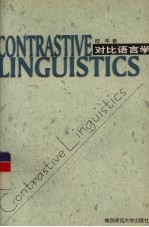

对比语言学 英文版PDF电子书下载
- 电子书积分:11 积分如何计算积分?
- 作 者:柯平编著
- 出 版 社:南京:南京师范大学出版社
- 出版年份:1999
- ISBN:7810472895
- 页数:271 页
CHAPTER 1 INTRODUCTION 1
1.1 What is Contrastive Linguistics? 1
1.1.1 Name and Nature 2
1.1.1.1 Linguistics 2
1.1.1.2 Contrastive Linguistics 5
1.1.2 Classification 10
1.1.2.1 Theoretical and Applied Contrastive Linguistics 10
1.1.2.2 Micro-contrastive and Macro-contrastive Linguistics 16
1.2 Why Contrastive Linguistics? 17
1.3 History and Development 26
Study Questions 33
CHAPTER 2 PRINCIPLES AND PROCEDURES 35
2.1 Basic Assumptions & Hypotheses 35
2.1.1 Transfer:the Psychological Basis of Contrastive Analysis 35
2.1.2 The Strong and Weak Versions of CA Hypothesis 37
2.1.3 The Predictive Power of Contrastive Analysis 39
2.2 Criteria for Comparison 41
2.2.1 The Surface Structure(SS) 42
2.2.2 The Deep Structure(DS) 45
2.2.3 Translation Equivalence 51
2.3 Procedures 57
Study Questions 58
CHAPTER 3 PHONETIC & PHONOLOGICAL CONTRASTIVE ANALYSES 61
3.1 Phonetics and Phonology 61
3.2 Contrastive Phonetics 63
3.3 Contrastive Phonology 67
3.3.1 Phonological Contrastive Analysis 67
3.3.2 Two Phonological Models 69
3.4 Suprasegmental Contrastive Analysis 73
Study Questions 76
CHAPTER 4 LEXICAL CONTRASTIVE ANALYSIS 78
4.1 Contrastive Lexical Morphology 79
4.2 Contrastive Lexical Semantics 83
4.2.1 Motivation of Words 84
4.2.2 Sense Relationships 89
4.2.2.1 Syntagmatic Semantic Relationship:Collocation 90
4.2.2.2 Paradigmatic Semantic Relationships 92
4.2.2.3 Lexical Fields and Lexical Gaps 95
4.2.3 Semantic Features 100
4.3 Three Active Areas 105
Study Questions 117
CHAPTER 5 GRAMMATICAL CONTRASTIVE ANALYSIS 120
5.1 Contrastive Analysis of Inflectional Morphology 122
5.1.1 Aspect 124
5.1.2 Case 125
5.1.3 Gender 126
5.1.4 Mood 127
5.1.5 Number 127
5.1.6 Person 127
5.1.7 Tense 128
5.1.8 Voice 128
5.2 Syntactic Contrastive Analysis 133
5.2.1 Structuralist Approach(Surface-structure Contrasts) 134
5.2.2 Generative Approach 140
5.2.2.1 Transformational Grammarian Approach(Deep-structure Contrasts) 140
5.2.2.2 Case Grammarian Approach(Deeper-structure Contrasts) 149
Study Questions 157
CHAPTER 6 TEXTUAL CONTRASTlVE ANALYSIS 159
6.1 Text and Discourse 162
6.2 Defining Characteristics of the Text 163
6.3 Contrastive Analysis of Textual Cohesion 166
6.3.1 Semantic Cohesion 168
6.3.1.1 Reference 168
6.3.1.2 Substitution 172
6.3.1.3 Ellipsis 173
6.3.1.4 Conjunction 176
6.3.1.5 Lexical Relationships("Lexical Cohesion") 181
6.3.2 Structural Cohesion 182
6.3.2.1 Parallelism 183
6.3.2.2 Comparison 188
6.2.2.3 Information Structure 189
6.3.3 Different Languages Preferring Different Cohesive Devices 201
6.4 Contrastive Analysis of Textual Coherence 203
Study Questions 213
CHAPTER 7 PRAGMATIC CONTRASTIVE ANALYSIS 215
7.1 Speech Act Theory(Unilateral Communication) 215
7.1.1 Speech Acts 216
7.1.2 Felicity Conditions 218
7.2 Conversational Interaction(Bilateral Communication) 220
7.2.1 Structural Components of Conversation 220
7.2.1.1 Openings 221
7.2.1.2 Maintaining Conversation 223
7.2.1.3 Closings 229
7.2.2 Principles of Conversational Organization 231
7.2.2.1 The Principle of Cooperation(Be Clear) 232
7.2.2.2 Rules of Politeness(Be Polite) 237
Study Questions 242
REFERENCES 244
INDEX 254
- 《卓有成效的管理者 中英文双语版》(美)彼得·德鲁克许是祥译;那国毅审校 2019
- 《程序逻辑及C语言编程》卢卫中,杨丽芳主编 2019
- 《幼儿园课程资源丛书 幼儿园语言教育资源》周兢编 2015
- 《AutoCAD 2018自学视频教程 标准版 中文版》CAD/CAM/CAE技术联盟 2019
- 《妈妈365天英语》(韩)申艺莉著 2014
- 《跟孩子一起看图学英文》张紫颖著 2019
- 《好课是这样创成的 语文卷》雷玲主编 2020
- 《高等学校“十三五”规划教材 C语言程序设计》翟玉峰责任编辑;(中国)李聪,曾志华,江伟 2019
- 《AutoCAD机械设计实例精解 2019中文版》北京兆迪科技有限公司编著 2019
- 《音乐语言的根基》张艺编著 2019
- 《市政工程基础》杨岚编著 2009
- 《家畜百宝 猪、牛、羊、鸡的综合利用》山西省商业厅组织技术处编著 1959
- 《《道德经》200句》崇贤书院编著 2018
- 《高级英语阅读与听说教程》刘秀梅编著 2019
- 《计算机网络与通信基础》谢雨飞,田启川编著 2019
- 《看图自学吉他弹唱教程》陈飞编著 2019
- 《法语词汇认知联想记忆法》刘莲编著 2020
- 《培智学校义务教育实验教科书教师教学用书 生活适应 二年级 上》人民教育出版社,课程教材研究所,特殊教育课程教材研究中心编著 2019
- 《国家社科基金项目申报规范 技巧与案例 第3版 2020》文传浩,夏宇编著 2019
- 《流体力学》张扬军,彭杰,诸葛伟林编著 2019
- 《大学计算机实验指导及习题解答》曹成志,宋长龙 2019
- 《大学生心理健康与人生发展》王琳责任编辑;(中国)肖宇 2019
- 《大学英语四级考试全真试题 标准模拟 四级》汪开虎主编 2012
- 《大学英语教学的跨文化交际视角研究与创新发展》许丽云,刘枫,尚利明著 2020
- 《复旦大学新闻学院教授学术丛书 新闻实务随想录》刘海贵 2019
- 《大学英语综合教程 1》王佃春,骆敏主编 2015
- 《大学物理简明教程 下 第2版》施卫主编 2020
- 《大学化学实验》李爱勤,侯学会主编 2016
- 《天水师范学院60周年校庆文库 新工科视域下的工程基础与应用研究》《天水师范学院60周年校庆文库》编委会编 2019
- 《中国综合性大学法语学科表征研究》田园著 2019
